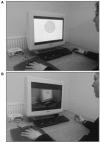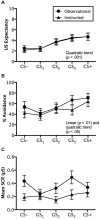Generalization of socially transmitted and instructed avoidance
- PMID: 26150773
- PMCID: PMC4471372
- DOI: 10.3389/fnbeh.2015.00159
Generalization of socially transmitted and instructed avoidance
Abstract
Excessive avoidance behavior, in which an instrumental action prevents an upcoming aversive event, is a defining feature of anxiety disorders. Left unchecked, both fear and avoidance of potentially threatening stimuli may generalize to perceptually related stimuli and situations. The behavioral consequences of generalization mean that aversive learning experiences with specific threats may lead to the inference that classes of related stimuli are threatening, potentially dangerous, and need to be avoided, despite differences in physical form. Little is known however about avoidance generalization in humans and the learning pathways by which it may be transmitted. In the present study, we compared two pathways to avoidance-instructions and social observation-on subsequent generalization of avoidance behavior, fear expectancy and physiological arousal. Participants first learned that one cue was a danger cue (conditioned stimulus, CS+) and another was a safety cue (CS-). Groups were then either instructed that a simple avoidance response in the presence of the CS+ cancelled upcoming shock (instructed-learning group) or observed a short movie showing a demonstrator performing the avoidance response to prevent shock (observational-learning group). During generalization testing, danger and safety cues were presented along with generalization stimuli that parametrically varied in perceptual similarity to the CS+. Reinstatement of fear and avoidance was also tested. Findings demonstrate, for the first time, generalization of socially transmitted and instructed avoidance: both groups showed comparable generalization gradients in fear expectancy, avoidance behavior and arousal. Return of fear was evident, suggesting that generalized avoidance remains persistent following extinction testing. The utility of the present paradigm for research on avoidance generalization is discussed.
Keywords: anxiety disorders; avoidance; fear-conditioning; generalization; instructed-learning; observational-learning.
Figures





Similar articles
-
Learned, instructed and observed pathways to fear and avoidance.J Behav Ther Exp Psychiatry. 2016 Mar;50:106-12. doi: 10.1016/j.jbtep.2015.06.003. Epub 2015 Jun 23. J Behav Ther Exp Psychiatry. 2016. PMID: 26143446
-
Safe from harm: learned, instructed, and symbolic generalization pathways of human threat-avoidance.PLoS One. 2012;7(10):e47539. doi: 10.1371/journal.pone.0047539. Epub 2012 Oct 15. PLoS One. 2012. PMID: 23077631 Free PMC article.
-
Fear learning, avoidance, and generalization are more context-dependent for adults than adolescents.Behav Res Ther. 2021 Dec;147:103993. doi: 10.1016/j.brat.2021.103993. Epub 2021 Oct 30. Behav Res Ther. 2021. PMID: 34740098
-
Fear Generalization and Anxiety: Behavioral and Neural Mechanisms.Biol Psychiatry. 2015 Sep 1;78(5):336-43. doi: 10.1016/j.biopsych.2015.04.010. Epub 2015 Apr 20. Biol Psychiatry. 2015. PMID: 25981173 Review.
-
Perceptual variability: Implications for learning and generalization.Psychon Bull Rev. 2021 Feb;28(1):1-19. doi: 10.3758/s13423-020-01780-1. Psychon Bull Rev. 2021. PMID: 32869189 Review.
Cited by
-
Assessment of social transmission of threats in humans using observational fear conditioning.Nat Protoc. 2017 Jul;12(7):1378-1386. doi: 10.1038/nprot.2017.027. Epub 2017 Jun 15. Nat Protoc. 2017. PMID: 28617449
-
Emotions, Religious Faith, and Coping Strategies of Ukrainians at the Beginning of the 2022 Russo-Ukraine War: A Qualitative Study.J Relig Health. 2025 Jun;64(3):1934-1953. doi: 10.1007/s10943-024-02221-2. Epub 2024 Dec 24. J Relig Health. 2025. PMID: 39718720
-
Methodological implications of sample size and extinction gradient on the robustness of fear conditioning across different analytic strategies.PLoS One. 2022 May 24;17(5):e0268814. doi: 10.1371/journal.pone.0268814. eCollection 2022. PLoS One. 2022. PMID: 35609058 Free PMC article.
-
Isolation of the differential effects of chronic and acute stress in a manner that is not confounded by stress severity.Neurobiol Stress. 2024 Feb 10;30:100616. doi: 10.1016/j.ynstr.2024.100616. eCollection 2024 May. Neurobiol Stress. 2024. PMID: 38384783 Free PMC article.
-
Training discrimination diminishes maladaptive avoidance of innocuous stimuli in a fear conditioning paradigm.PLoS One. 2017 Oct 12;12(10):e0184485. doi: 10.1371/journal.pone.0184485. eCollection 2017. PLoS One. 2017. PMID: 29023466 Free PMC article.
References
-
- American Psychiatric Association (2013). Diagnostic and Statistical Manual of Mental Health Disorders: DSM-5. 5th Edn. Washington, DC: American Psychiatric Publishing.
-
- Boddez Y., Baeyens F., Hermans D., Beckers T. (2014). “A learning theory approach to anxiety disorders: human fear conditioning and the added value of complex acquisition procedures,” in The Wiley Handbook of Anxiety Disorders, eds Emmelkamp P., Ehring T. (Chichester: John Wiley and Sons, Ltd; ), 85–103.
-
- Broeren S., Lester K. J., Muris P., Field A. P. (2011). They are afraid of the animal, so therefore I am too: influence of peer modeling on fear beliefs and approach-avoidance behaviors towards animals in typically developing children. Behav. Res. Ther. 49, 50–57. 10.1016/j.brat.2010.11.001 - DOI - PubMed
LinkOut - more resources
Full Text Sources
Other Literature Sources

